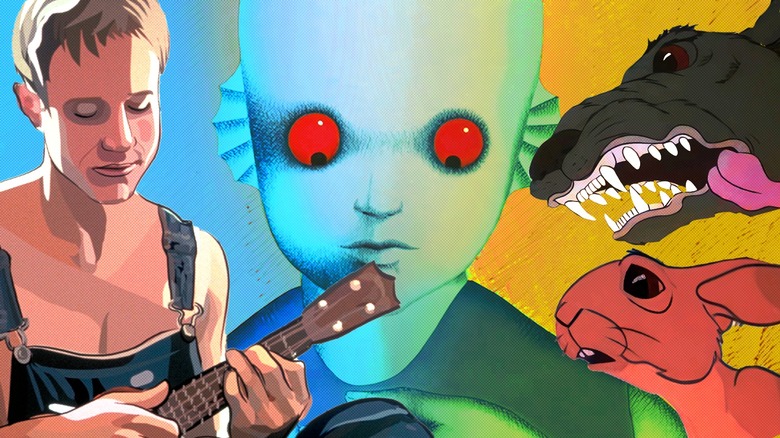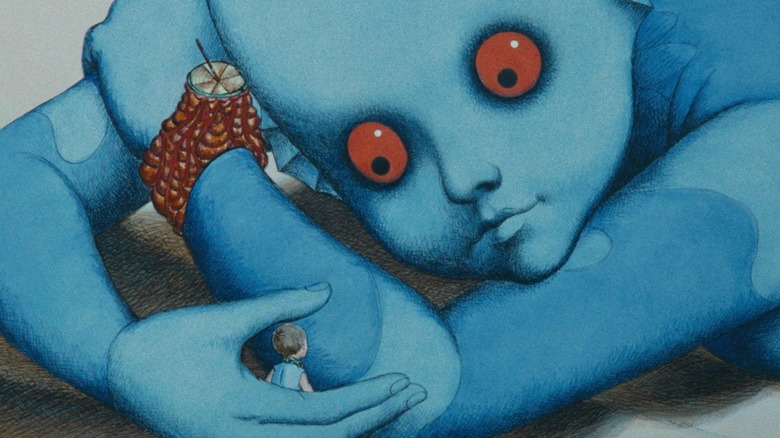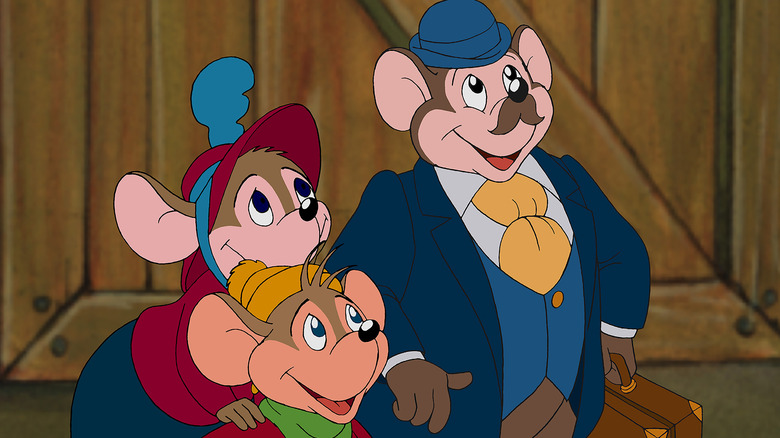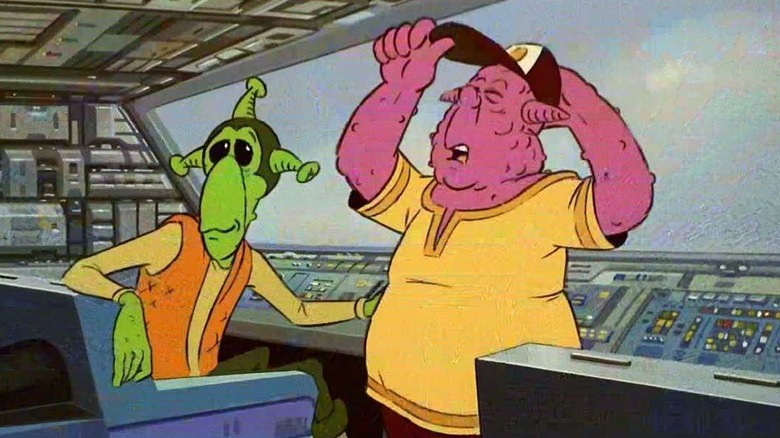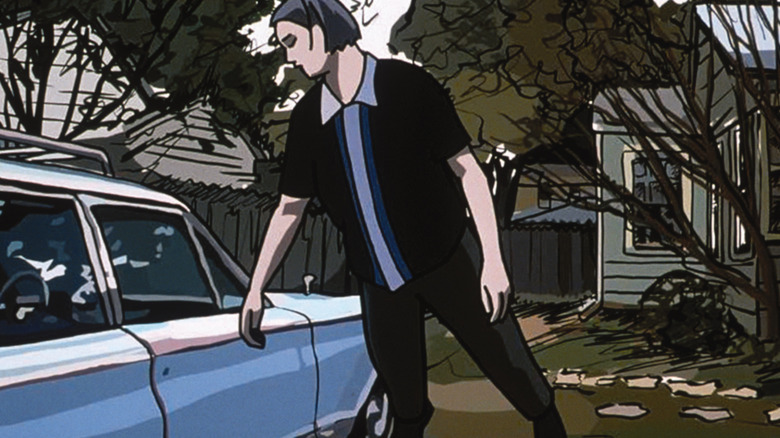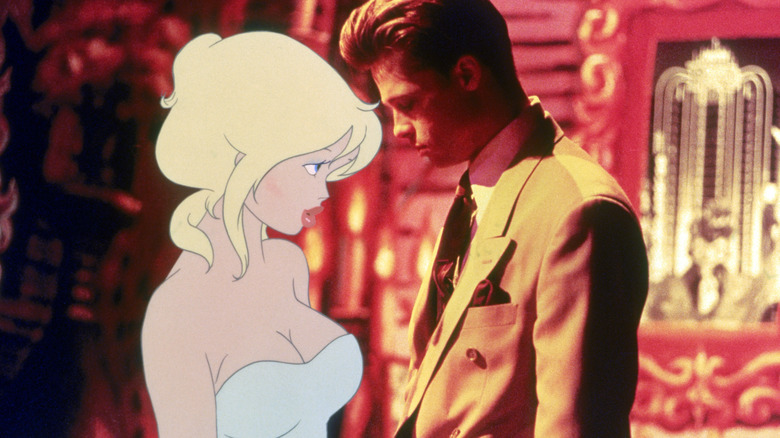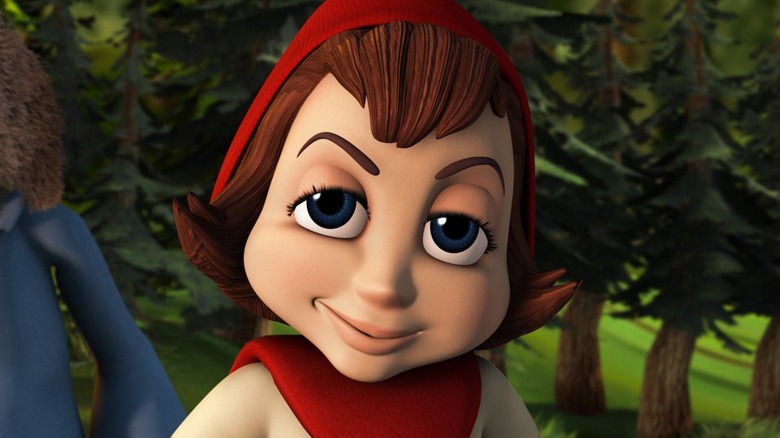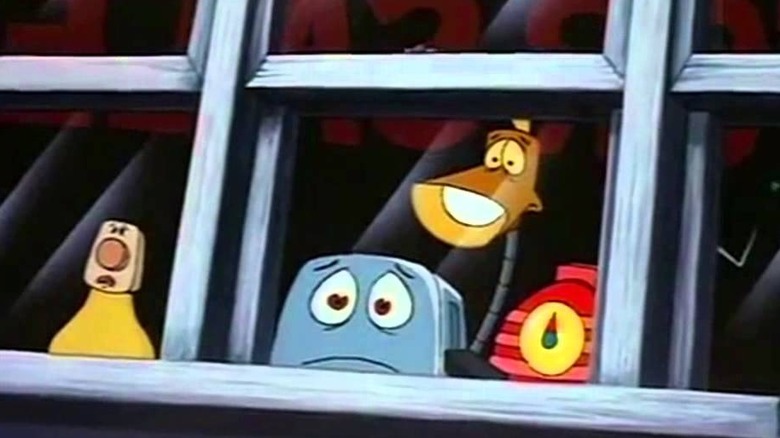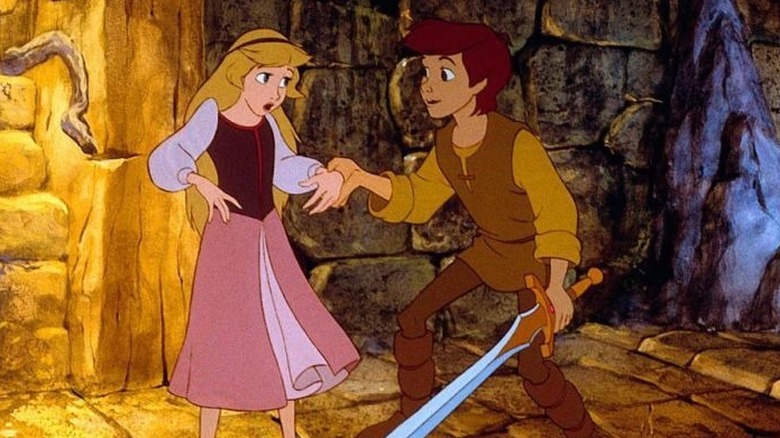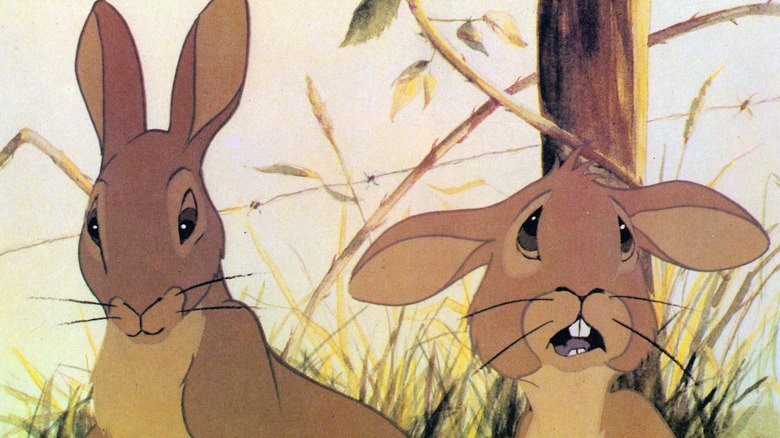Animated Movies People Still Don't Understand
We're living through a golden age of animation on the big screen with incredible pieces of art like "Puss in Boots: The Last Wish," "Turning Red," and "Guillermo del Toro's Pinocchio" pushing boundaries of what can be done with the medium. Despite how visually impressive they are, most of these more mainstream animated movies are pretty straightforward in terms of plot and themes. Nobody walks out of a screening of "Encanto" confused about what happened in the story or what the lesson to be learned is.
In some ways, animated movies are limited by their association with children's entertainment and the restrictions therein. While these movies can be visually dazzling and emotionally moving, it sometimes comes at the cost of filmmakers doing things that are genuinely unexpected. Animation can allow storytellers to be truly unchained from the laws of reality since they can create anything they can imagine without worrying about practicality.
Thanks to the beauty of animation as a medium, there are countless animated movies out there that do different things with the form than mainstream Disney fare. Some of these you may have heard of before, and others might be totally alien to you, but either way, they're definitely worth watching even if audiences still have a hard time figuring out what's going on in them. Read on to find out all the animated movies people still don't understand.
9
It wasn't too long ago when the Tim Burton-produced CG-animated film "9" hit theaters to resoundingly mediocre reception. This was a movie that had a lot going for it before release, including a star-studded voice cast and a seemingly interesting post-apocalyptic premise. It featured the talent of performers such as John C. Riley, Jennifer Connelly, Christopher Plummer, Crispin Glover, and Martin Landau in starring roles as creepy little robot dolls reanimated in a post-apocalypse.
"9" is centered around a doll named 9 who must fight against an evil artificial intelligence that has destroyed all life on Earth. While the movie had interesting concepts and ideas, it failed to present them in a coherent way, especially in a way that kids could understand. The story focused on nine self-conscious rag dolls, called "Stitchpunks," which contained different aspects of their scientist's creator's soul (via Gizmodo). 9 himself (voiced by Elijah Wood) is based on their creator's inherent humanity and functions as the heart of the team. Other stitchpunks instead have traits like healing, fighting, fear, creativity, and arrogance which are all meant to work together in unison. While this may seem interesting on the surface, "9" struggles to explain these complex ideas in an engaging way.
Fantastic Planet
When it comes to really weird experimental animated films, it doesn't get more iconic than René Laloux's "Fantastic Planet." This 1973 piece of science fiction was a unique co-production between French and Czechoslovakian filmmakers centered around humans in the far future living on a planet controlled by gigantic blue humanoids. Humans in this world are treated as pets, and the plot mainly focuses on the relationship between the alien Tiwa and a human child taken in as a pet, named Terr.
"Fantastic Planet" is a gorgeous, strange, and appropriately fantastic film that nonetheless confuses many audiences thanks to its deeper subtext. The entire movie is an allegorical story representing many social issues such as animal rights abuses, racism, and human rights in general. Much of this can be lost on viewers who don't fully understand the connection between the mesmerizing visuals of "Fantastic Planet" and their connection to these deeper themes. It certainly doesn't help that the English-language dub of the film completely altered parts of the dialogue and story in an attempt to make it more "kid-friendly" (via TV Guide). So, if you give "Fantastic Planet" a try make sure to watch it in the original French release.
Titanic: The Legend Goes On
Yeah, you're reading this right. Somebody actually made an animated musical comedy about the Titanic sinking. This is real. Camillo Teti's "Titanic: The Legend Goes On" is an Italian re-imagining of this actual historical event with the addition of creative liberties such as talking animals and musical numbers. Obviously spinning off the success of James Cameron's 1997 blockbuster, "Titanic," this movie baffled the minds of anyone who watched it because of how unbelievably bad it was.
Unlike its cinematic predecessor, "Titanic: The Legend Goes On" has little regard for the actual story of the Titanic and instead adds things you'd typically see in a standard children's animation film. The story is focused on the budding relationship between a third-class passenger named Angelica and an upper-crust rich man named William, which probably sounds familiar. What's really confusing is the addition of multiple talking animals ripped straight from a different movie such as a band of mariachi mice, a rapping dog, and a talking magpie. "Titanic: The Legend Goes On" has gone on to be considered one of the worst animated movies of all time by both critics and audiences alike. Christopher Campbell of Indiewire put it best in his piece, "100 Years of Terrible 'Titanic' Exploitations in Film, TV and Slides," by describing the film as, "so terribly written and drawn that it's offensive to the Titanic's memory."
Heavy Metal
"Heavy Metal" is one of the wildest movies of the 1980s, featuring a wild mixture of intense sci-fi visuals with a hardcore rock soundtrack that still slaps to this day. Coming to us from director Gerald Potterton and produced by comedy legend Ivan Reitman, this movie is best known for its gratuitous content rather than its narrative cohesion. Some of the iconic bands to have their music featured in the film include Blue Öyster Cult, Black Sabbath, DEVO, Journey, and Cheap Trick to name just a few.
What makes "Heavy Metal" so confusing isn't that it's a bad movie since it's actually a fascinating relic of excessive 1980s culture. It's confusing because the film is a series of mostly unrelated vignettes strung together into a disjointed anthology of violence and rock and roll. The only thing connecting all the different segments of "Heavy Metal" is a vague unifying concept of "the sum of all evils" being present. These days the film is more famous for being parodied by South Park in the season 12 episode "Major Boobage," which makes much more sense than the movie since it's all just a drug-induced hallucinogenic trip that Kenny endures.
Waking Life
Confusing animation isn't just reserved for over-the-top science fiction and bafflingly bad cash-ins, sometimes even prestige filmmakers dip their toes into this kind of thing. That's where Richard Linklater comes in with his 2001 experimental film, "Waking Life," which chronicles a man stumbling his way through multiple unrelated realities in a fugue state. What makes this movie so unique is the style of animation used called rotoscoping which allows real-life actors to essentially be painted over with 1-1 animation (via Wired). Rotoscoping has become popular once again thanks to online content creators such as Joel Haver using it for comedic effect, but at the time this was a wholly unusual way of making a movie.
"Waking Life" is unabashedly an experimental film without any kind of cohesive storyline for audiences to latch on to. It follows in the footsteps of Linklater's previous film, "Slacker," by meandering from scene to scene and character to character without any connections between them. "Waking Life" also hinges on complicated (and pretentious) philosophical themes which are constantly being discussed by the characters as the film progresses. Although the film has notable critical acclaim with an 80% on Rotten Tomatoes, it nonetheless can be an inscrutable and confusing film for audiences who enjoy a comprehensible plot.
Cool World
1988's "Who Framed Roger Rabbit" proved to the world that combining live-action with animations can work perfectly in a mainstream Hollywood movie by having real people seamlessly interact with cartoon characters in the same scene. On the other hand, 1992's "Cool World" equally proved that it can totally backfire when your movie isn't very good. Ralph Bakshi's attempt to piggyback on the success of Robert Zemeckis' more popular film featured a young Brad Pitt as a noir detective for the cartoon landscape of Cool World.
What makes "Cool World" a failure is not just that the animation was bad (which it was), but that the story was borderline incomprehensible. Critics at the time such as Peter Rainer of The Los Angeles Times noted just how hard it was to enjoy a movie that is impossible to follow. In his 1992 review, he stated, "[T]he plot makes almost no sense." It doesn't help that the film was consistently compared to the much better-received "Who Framed Roger Rabbit" at almost every turn since that movie has an easy-to-follow mystery narrative. After all, there's a reason that "Cool World" has gone down as one of the most hated movies of all time despite some success as a cult classic with certain fans (via Dazed).
Hoodwinked!
"Hoodwinked!," a 2005 comedy mystery, has earned an infamous reputation in recent years for being one of the worst-looking animated movies of its time. "Hoodwinked!" was the brainchild of director Cory Edwards as a comedic re-imagining of the classic "Little Red Riding Hood" fairy tale told as a gritty police crime drama. While it's clearly trying to follow in the footsteps of tongue-in-cheek fantasy comedies like 2001's "Shrek," this too attempts to make meta jokes about its subject matter through wacky characters like Wolf W. Wolf (voiced by Patrick Warburton) and Abigail "Granny" Puckett (voiced by Glenn Close).
In fact, one of the most baffling things about "Hoodwinked!" is how a movie as cheap looking as this could score such an impressive supporting cast. This film features the acting talent of Anne Hathaway, Jim Belushi, Anthony Anderson, David Ogden Stiers, Chazz Palminteri, Tom Kenny, and Ken Marino all in prominent roles as various fairy tale creatures. "Hoodwinked!" also boasts an overly-complicated plot that tries to subvert the tropes of the stories being parodied by making the Big Bad Wolf an innocent slacker while the true villain is actually the cute little rabbit named Boingo. Based on an overwhelmingly negative critical reception with 46% on Rotten Tomatoes, it's clear that "Hoodwinked!" failed to be either clever or amusing.
The Brave Little Toaster
Unlike some of the other animated movies on this list, "The Brave Little Toaster" films are actually really great. Having started in 1987 with the first movie, these musical comedies follow the heartwarming quest of a sentient toaster and his appliance friends as they try to reunite with their lost owner. Similar to Pixar's "Toy Story" franchise, which would come years later, the inanimate objects of this world are all actually alive but pretend to be dormant whenever a human is around.
While the story of "The Brave Little Toaster" is easy enough to follow for audiences, what really makes these films so confusing for younger audiences is just how intense they are. Because of its nature as an independent feature film, the creators were able to put in much darker themes than what would've been allowed with rival companies such as Disney or Warner Brothers. "The Brave Little Toaster" puts its main characters into genuine, life-threatening danger multiple times throughout the narrative in ways that totally scared some of the younger kids watching. One musical number stands out as being confusingly dark since it depicts sentient cars at a junkyard singing about their worthlessness before being crushed to death by a large machine. Critic Walter Chaw described the film best in his review for Film Freak Central by describing it as, "'Blade Runner' for children."
The Black Cauldron
"The Black Cauldron" stands out as being a "lost ” Disney movie, forgotten to time and rarely referenced in discussions of the company's greatest animated works. Nonetheless, the film has gained a significant cult following over the years thanks to its uniquely dark, complex, and intriguing world that stands out during a particularly slow era of animation. "The Black Cauldron" features a surprisingly stacked cast of voice performers including John Huston, John Hurt, Susan Sheridan, and Freddie Jones.
Although it has gained some appreciation in recent years, "The Black Cauldron" is mostly seen as an overly-ambitious and mostly confusing piece of dark fantasy filmmaking. This film introduces an entirely new, deep, and fleshed-out fantasy setting with the realm of Prydain, controlled by the evil Horned King (based on "The Chronicles of Prydain" book series). It follows the journey of a young man named Taran who tries to stop the devious king from getting a powerful black cauldron that will help him completely conquer the world. Charles Champlin of The Los Angeles Times succinctly described the problem with "The Black Cauldron" by saying it lacked "the simplicity and the clarity of great fairy tales."
Watership Down
1978's "Watership Down" was a film adaptation of an earlier novel by Richard Adams, which follows the story of adorable talking rabbits in the English countryside. "Watership Down" has become known for its deeply imaginative lore, compelling narrative, and poignant message on the necessity of preserving the natural world. What makes this animated film confusing for many viewers is the dichotomy between the cutesy cartoon look of the rabbits contrasted with the intense, foreboding imagery of death and the destruction of their environment.
"Watership Down" features an intricately crafted world that Richard Adams created in his original novel with its own mythology that's presented in the movie. According to a 2014 Reddit AMA with Adams, he crafted an entire rabbit language for the story called "Lapine" that the creatures speak. He said, "I just constructed Lapine as I went — when the rabbits needed a word for something, so did I." For many audiences watching "Watership Down," this all may be a bit overwhelming for a movie that looks like it would be about cute little rabbits being cute together. David Robinson of The Times noted in his piece "Down the rabbit hole and into Disneyland" that people watching without knowledge of the book beforehand may struggle to keep up, adding that they might have "a little difficulty with the special lore and language of Richard Adams' rabbit civilization."
